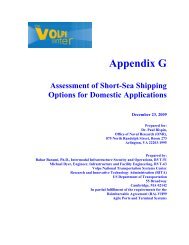ERRV Viking Islay - Marine Accident Investigation Branch
ERRV Viking Islay - Marine Accident Investigation Branch
ERRV Viking Islay - Marine Accident Investigation Branch
- No tags were found...
Create successful ePaper yourself
Turn your PDF publications into a flip-book with our unique Google optimized e-Paper software.
Samples were taken from three different depths within the chain locker, on both the portand starboard sides. Their findings are summarised below:• Atmosphere measurements (samples taken)O 2 : 15 - 19%; Nitrogen (N): 78 - 82%; Argon: 1 - 1.1%; Carbon Dioxide (CO 2 ):0.07 - 0.14 ppm; CO: 0 - 4 ppm, H 2 S: 0 ppm.• The reduced concentration of O2 was consistent with that obtained by a directreading instrument on-site.• The slightly increased levels of CO2 might be due to microbial action on organicmaterials in the chain locker. However, these concentrations are within acceptablelimits.• The analysis of the samples also indicated very low concentrations of volatileorganic compounds, within acceptable limits.1.4.2HSE opinionThere were no significant amounts of toxic gases in the chain locker, and the internalsteel surfaces (including the anchor chains) were heavily rusted.The increased concentration of Argon (compared to the air reference value of 0.97%)indicated depletion of O 2 , rather than another gas displacing or diluting air within thechain locker.Iron and steel when exposed to moist air will react with O 2 in the air to form iron oxide(rusting). Rusting requires both O 2 and water and is accelerated in the presence ofsalt. The corrosion of the steel within the chain locker caused the O 2 to be consumedin the process of rust formation, and this resulted in an O 2 deficient atmosphere.The atmospheric measurements reported were taken 3 days after the accident. In theinterim, the space had been opened, and rescuers wearing BA had been working in thespace. As a consequence, the air quality measurements taken were not representativeof the atmosphere in the chain locker at the time of the accident.The chain locker was tightly sealed with, effectively, no natural ventilation being presentprior to the entry by the three crewmen. It is difficult to estimate the concentration ofO 2 at the time of the accident, but based on the speed of effect and available data fromother incidents it is likely that O 2 concentrations in the chain locker at the time of theaccident were below 10%.In the opinion of the specialist HSE inspector, the depleted O 2 concentration in thechain locker was the primary reason for the collapse and subsequent death of the threecrewmen.11
















